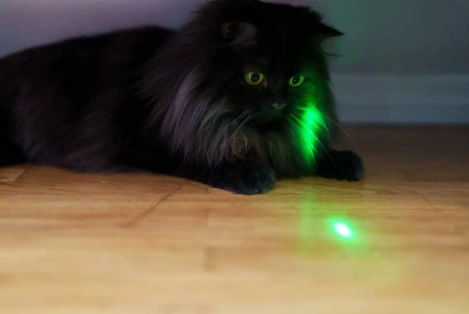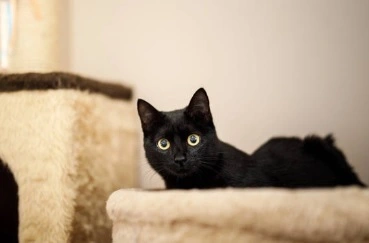As you watch your cat pounce on invisible prey or stare intently at empty space, you may wonder – can cats see infrared light or detect things imperceptible to humans? Your feline’s vision does work differently than yours in terms of ranges and sensitivities. Read on to learn how cats see the world compared to human eyesight.
Can cats see infrared? Learn whether feline vision truly detects infrared light, heat signatures and other invisible phenomena beyond the range of human eyes.
How Do Cat Eyes Differ From Human Eyes?
Cats are crepuscular – most active at dawn and dusk. Their eyesight evolved to specialize in low light conditions. Differences from human eyes include:
- Large Corneas – Allow more light to enter the eye
- Tapetum lucidum – Reflective layer magnifies light through retina
- High Rod Density – Increased receptors detect dim light
- Vertical Slit Pupils – Adjust quickly based on light levels
- Wide Peripheral Vision – Detect motion across ~200 degrees
- Limited Color Vision – See blues/greens but fewer reds
- Close Focusing Distance – Allows pouncing accuracy
Combined, these adaptations give cats excellent nighttime vision and motion detection vital for hunting. But they lack sharp detail and color perception compared to human eyes.
Can Cats See Infrared Light?
Infrared light exists outside the visible light spectrum, with wavelengths longer than humans can perceive. While cats can’t see the full infrared spectrum, vision of cat extends slightly beyond ours in the near-infrared range.
Studies show cats see wavelengths up to 1200 nanometers, compared to humans seeing only up to 700 nm. This expanded spectral range, plus their light-gathering retinal structures, allows cats to see in very low illumination.

But cats likely can’t visualize the longer wavelength thermal or far-infrared emission we associate with night vision goggles or thermal cameras. vision of cat still has limits!
Do Cats See Infrared Camera Lights?
Infrared security cameras emit near-infrared wavelengths to allow night filming invisible to humans. We simply see darkness when the IR lights activate. But with their wider spectral perception, cats likely see the infrared camera lights as a faint glow or flare when they switch on.
The IR lights appear significantly dimmer and less defined than visible lights. But vision of cat is sensitive but it can still pick up the infrared camera emissions, while humans see only blackness. This causes the eerie effect of cats staring at or pouncing on thin air when security footage rolls!
Can Cats See Infrared TV Remotes and Pointers?
Handheld remotes, laser pointers, and cat toys often use infrared LEDs rather than visible light. This allows the devices to emit signals while appearing dark to human eyes. This article helps to explore everything about can cats see infrared.
Since feline vision detects near-infrared wavelengths, cats can see the pulsing beams from TV remotes and the pinpoint dots of infrared laser pointers. Their brains likely process these faint infrared flashes as rapid motion cues triggering their prey drive.
This explains why infrared cat toys effectively capture their attention and provoke energetic pouncing, stalking, and chasing behaviors! The infrared emissions resemble natural prey movement.
Do Cats Perceive Infrared Heat Signatures?
All warm-blooded creatures emit infrared radiation as body heat. Specialized cameras can visualize these radiated heat signatures in total darkness.

But feline eyes lack the additional adaptations needed to detect infrared thermal radiation and turn it into imagery. While cats have excellent night vision compared to humans, they cannot see living things based on their emitted heat profile alone in infrared.
Can Cats See Ultraviolet Light?
Ultraviolet light has even shorter wavelengths than human visible light perception. Some animals, like birds, bees, and reindeer see into the near-UV range. But mammalian lenses filter out most UV light to protect the retina.
Cats can see traces of UV compared to humans, lending a violet-blue cast to their vision. But they lack substantial ultraviolet perception. Overall, feline vision focuses mainly on the wider visible light ranges.
Do Cats Have Better Night Vision Than Humans?
With 6-8 times more rod receptors aiding dim light vision, cats definitely see better at night than humans! Other enhancements like their tapetum lucidum membrane multiplying scarce light also give cats an advantage after dusk.
In starlight alone, cats have ~8 times greater visual acuity and light sensitivity than people. Their pupils also open wider than human eyes, adjusting faster to maximize traces of light. By moonlight, vision of cat remains many times sharper than a human’s.
So when it seems pitch black to you, cats can still navigate and observe activity fairly well. Just follow your nocturnal kitty’s confident lead on shadowy nights!
Can Cats See in Total Darkness or Red Light?
Despite their excellent night vision, cats cannot see in complete darkness or red light. Their eyes still require at least traces of blue-green light to function.
Red light appears dark to feline eyes since they lack substantial red-detecting cone cells. Only blue and green wavelengths penetrate their vision. So regular flashlights and camera flashes unfortunately sabotage cats’ dilated night vision rather than helping.
Do Cats See Ghosts or Spirits Humans Can’t?
Tales of cats staring or caterwauling at invisible entities have fueled myths of felines seeing ghosts, spirits, demons or death omens that elude humans.
In truth, cats likely focus intently on ambient sounds, scents, breezes, temperatures, and movements imperceptible to us. Their sensitivity shines a light on subtle cues going unnoticed by less perceptive human senses.
But cats probably don’t see full-fledged apparitions and ghosts as depicted in folklore. Much seemingly paranormal cat behavior has perfectly natural explanations when we view the world through their superior sensory lens!
Can Other Animals See Infrared Light?
Among mammals, cats possess some of the most extensive ability to detect infrared light used for night vision. Other animals with IR perception include:
- Dogs – Also see into the near-infrared spectrum slightly beyond humans. Useful for night hunting.
- Snakes – Pit vipers like rattlesnakes possess heat-sensing facial pits detecting IR radiation.
- Bats – Specialized heat receptors allow sensing body heat of prey.
- Sharks – Can detect thermal radiation with special pores.
- Rodents – Some also have limited near-infrared vision like cats and dogs.
Beyond mammals, certain snakes, insects, and birds see into the ultraviolet range above human visual limits. But cats concentrate mainly on excelling in the low light environments they hunt and thrive in.
Why Does Cat Vision See Beyond Humans?
For ancestral cats and modern ferals who are active at night and dusk, the ability to utilize all traces of light meant the difference between eating or starving. Better nighttime eyesight improved their odds of a successful hunt.
Seeing glimpses into the infrared or ultraviolet also allows cats to spot the subtle movements of potential prey and partners unnoticed by predators focused on visible light ranges. This evolutionary edge ensured their survival as small hunter-scavengers.
Today’s house cats may not need these enhancements to thrive. But their extraordinary eyesight persists, giving cats a fascinating window into a visual world humans can scarcely imagine!


Leave a Reply